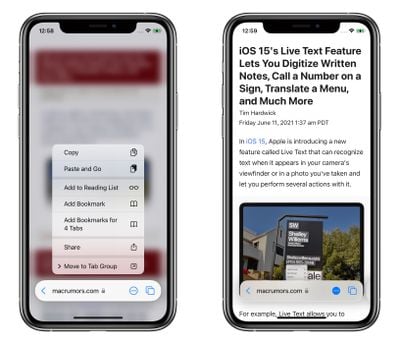Apple introduced a sweeping overhaul to its Safari browser's interface on iOS 15, iPadOS 15, and macOS Monterey, with a redesign that includes an address bar that floats at the bottom of the screen, changes to the way users switch tabs, and more.

Apple says this new-look Safari has been "reimagined for the way we browse today." In iOS 15, for example, Apple says the new floating address bar means Safari "maximizes your screen space and stays out of the way as you scroll and explore." However, some of the changes on both desktop and mobile have been heavily criticized by some users.
It turns out Google tried something similar in 2016 for its own home-grown browser. According to Chris Lee, a former Google designer, Google began developing a redesign for the Chrome mobile app called "Chrome Home" that was very similar to the one Apple is currently aiming at for Safari.
Lee was a staff interaction designer at Google at the time, and on his personal blog (via 9to5Google), Lee says he created the "original concept and pitch" for an "ambitious redesign of mobile Chrome's main UI."
It brought Chrome's toolbar to the bottom of the screen and turned [it] into a peeking panel that could be swiped to expose additional controls.
Swiping up on the address bar displayed the Discover and recent sites, Downloads, Bookmarks and History, while other features were accessible in a menu via an ellipsis (three dot) icon, which consolidated key browsing options and simplified one-handed operation in an era of growing screen sizes.
Lee says Chrome Home "caught traction internally, eventually becoming a Chrome org priority." However, after live beta tests and sustained experiments, the team received "a mixture of reactions."
The feature gained a cult following among the tech community, but for many mainstream users, the change felt disorienting. Chrome serves billions of users around the globe with varying tech literacy. Over the course of many iterations, I became increasingly convinced that launching Chrome Home would not serve all our users well.
So just as I strongly as I had pitched the original concept, I advocated for us to stop the launch - which took not a small amount of debate.
Ultimately, the redesign was killed off in 2018. Lee suggests that though Chrome Home was short-lived that doesn't mean it was a wasted effort, but rather a lesson about "the intentionality needed to innovate within a product of massive scale."
For Safari users, the question now is whether Apple's mixed feedback from its beta testers will be enough to steer the browser's redesign towards an end result that's more broadly acceptable to its user base, or if the company's intention lies in forcing through a change that it believes will grow on people given time.
Updates to iOS 15 Beta 3 and macOS Monterey Beta 3 suggest it could be the former: Apple has walked back some of the design changes it had in mind for Safari on both desktop and mobile, but we won't find out what the finished article will be like until both operating systems are released in September.






















